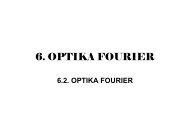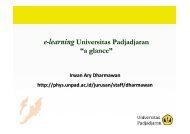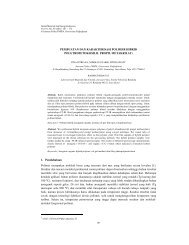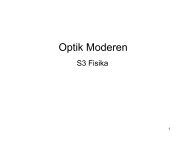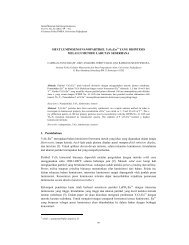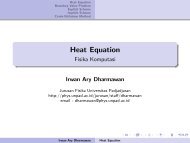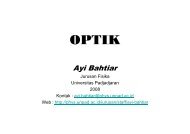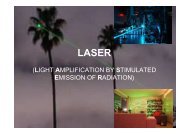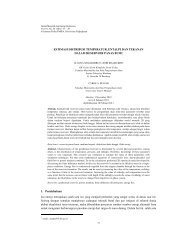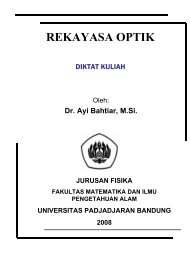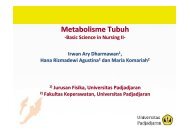NUCLEATION AND GROWTH OF Cu THIN FILMS ON SILICON ...
NUCLEATION AND GROWTH OF Cu THIN FILMS ON SILICON ...
NUCLEATION AND GROWTH OF Cu THIN FILMS ON SILICON ...
- No tags were found...
You also want an ePaper? Increase the reach of your titles
YUMPU automatically turns print PDFs into web optimized ePapers that Google loves.
Nucleation and Growth of <strong>Cu</strong> Thin Films on Silicon base Induced by Excimer Laser Annealing 733350.0 Torr. The laser capacitor voltage was kept constant at 12 kV. The laser was externallytriggered via a AFG310 function generator to control the number of pulses bellow 10 pulses. Thedimension of laser beam spot was 2 × 4 mm 2 . The a-Si films was exposed with different number ofpulses, n. Finally, nanostructure of the crystallized silicon was examined by AFM. Figure 1 showsthe schematic diagram of the experimental setup.3. Results and DiscussionThe nucleation and the growth of SI<strong>Cu</strong> thin film was observed via AFM. The typical ofobservation results are shown in Figure 2. The Si<strong>Cu</strong> crystallization are arranged in the increasingorder of the film crystallization. Prior annealing, the grain size of the amorphous silicon thin filmwas measured. The average nanocrystal size, G av of the a-Si film before doping and heating asshown in Figure 2(a) was measured to be approximately 17 nm. After experienced four hours withconventional annealing, the nucleation of crystal was observed to form new nanostructure. Thecrystallization pattern formation almost uniform with an increment of nanocrystal size up to 56nm as depicted in frame (b) of Figure 2.Immediately after exposed by a single shot of excimer laser, with corresponding energy density of65.50 mJcm -2 , the crystal growth was observed having new pattern nanostructure. Thecrystallization of the Si<strong>Cu</strong> film was accelerated to be 75 nm as illustrated in Figure 2(c). Thecrystallization of Si<strong>Cu</strong> film was observed continuously increasing after received the sequentialnumber of pulses from excimer laser.The maximum crystallization of Si<strong>Cu</strong> film occurs after received five number of pulses as depictedin Figure 2(g). The enlargement achieved approximately as 143 nm corresponding to the fluenceof 345 mJcm -2 . Beyond this critical energy for example after treatment with six number of pulseswhich corresponding to total energy density of 389 mJcm -2 , the crystallization reduced drasticallyas illustrated in Figure 2(h). Further decreasing was observed with higher number of pulses. Thesummarization profile of nucleation and the growth of Si<strong>Cu</strong> crystal is presented in Figure 3.The surface roughness due to the melted Si<strong>Cu</strong> thin film is an alternative parameter to indicate theintergration of crystalization formation. It is used to quantify the stress develop duringsolidification. The example of surface roughness measurement is shown in Figure 4. It comprisedthe agglomeration and coalesence of grain that cause even greater surface roughness especially athigher laser fluence. Consequently the surface roughness is increasing but not beyond the SLGlimit. The maximum surface roughness was obtained as 3 nm.In general the excimer laser was partially crystallize the Si<strong>Cu</strong> film at low energy density or at lownumber of exposure. As the energy density increases the film was totally melting and freezing.The UV light of excimer laser with temperature of 6.42 eV or equivalent with 7.5 × 10 4 K wasused to melt the film and activate the <strong>Cu</strong> to diffuse into silicon base. Considering the temporallength of pulse duration each of laser pulse was only 10 ns, this means the Si<strong>Cu</strong> film wasexperience ultra-speed heating and freezing. The energetic excimer can melted higher than adecalesence point. Consequently during rapid solidification its meet a recalesence point, wherebyspontaneous pattern formation occurs and begins crystallization. The higher the heat transferredinto the Si<strong>Cu</strong> film the greater the crystallization formation. But if the delivered energy greater thansuper lateral growth of the Si<strong>Cu</strong> film, the solidification occurs before meet the recalesence point,as a result no spontaneous pattern formation consequently no crystallization. Thenanocrystallization formation indicates the solidification form in an homogenous pattern.


